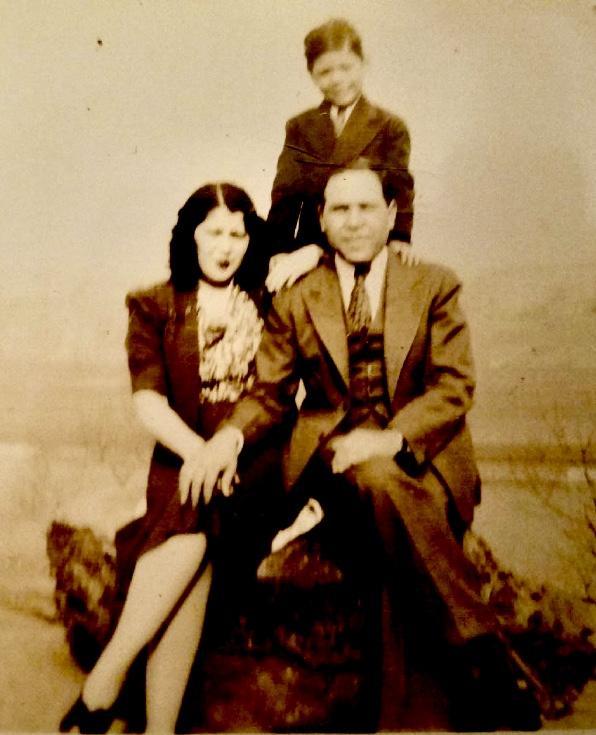Blog
Massive star IRS 4 is beginning to spread its wings. Born only about 100,000 years ago, material streaming out from this newborn star has formed the nebula dubbed Sharpless 2-106 Nebula (S106), featured here. A large disk of dust and gas orbiting Infrared Source 4 (IRS 4), visible in brown near the image center, gives the nebula an hourglass or butterfly shape. S106 gas near IRS 4 acts as an emission nebula as it emits light after being ionized, while dust far from IRS 4 reflects light from the central star and so acts as a reflection nebula. Detailed inspection of a relevant infrared image of S106 reveal hundreds of low-mass brown dwarf starslurking in the nebula’s gas. S106 spans about 2 light-years and lies about 2000 light-years away toward the constellation of the Swan (Cygnus).
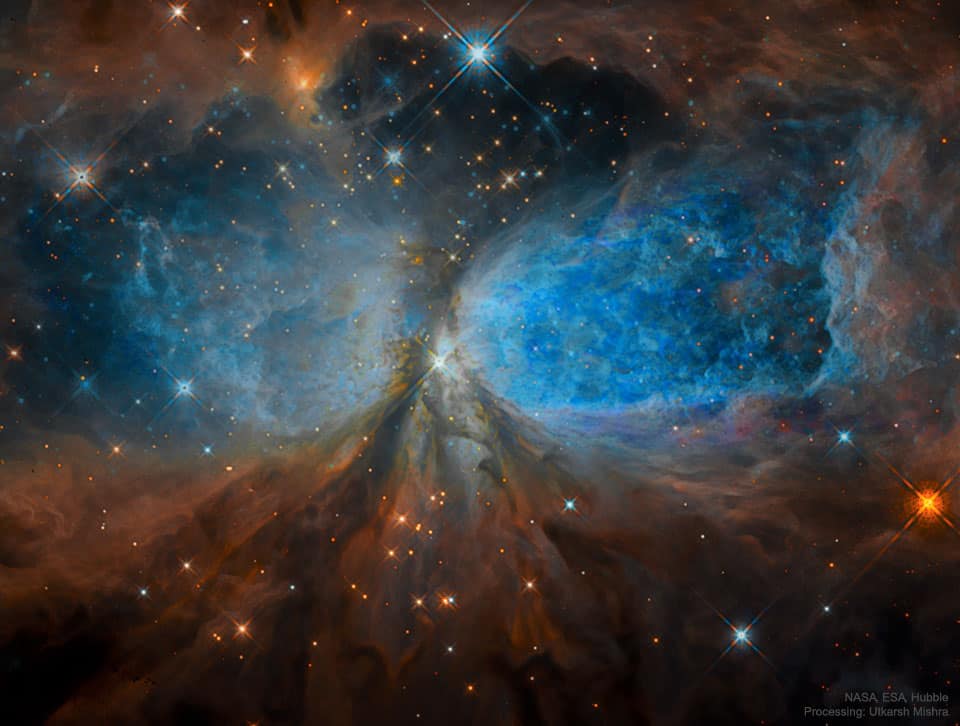
Sir Elton Hercules John CH CBE (born Reginald Kenneth Dwight; 25 March 1947) is an English singer, songwriter, pianist, and composer. He has worked with lyricist Bernie Taupin since 1967; they have collaborated on more than 30 albums. John has sold more than 300 million records, making him one of the best-selling music artists. He has more than fifty Top 40 hits in the UK Singles Chart and US Billboard Hot 100, including seven numbers ones in the UK and nine in the US, as well as seven consecutive number-one albums in the US. His tribute single “Candle in the Wind 1997“, rewritten in dedication to Diana, Princess of Wales, sold over 33 million copies worldwide and is the best-selling single in the history of the UK and US singles charts. He has also produced records and occasionally acted in films. John owned Watford F.C. from 1976 to 1987 and from 1997 to 2002. He is an honorary life president of the club.
Raised in the Pinner area of London, John learned to play piano at an early age, and by 1962 had formed Bluesology, an R&B band with whom he played until 1967. He met his longtime musical partner Taupin in 1967, after they both answered an advert for songwriters. For two years, they wrote songs for artists including Lulu, and John worked as a session musician for artists including the Hollies and the Scaffold. In 1969, John’s debut album, Empty Sky, was released. In 1970, his first hit single, “Your Song“, from his second album, Elton John, reached the top ten in the UK and the US. John has also had success in musical films and theatre, composing for The Lion King and its stage adaptation, Aida and Billy Elliot the Musical.
John has received five Grammy Awards, five Brit Awards, two Academy Awards, two Golden Globe Awards, a Tony Award, a Disney Legends award, and the Kennedy Center Honor. In 2004, Rolling Stone ranked him 49th on its list of 100 influential musicians of the rock and roll era. In 2013, Billboard ranked him the most successful male solo artist on the Billboard Hot 100 Top All-Time Artists, and third overall, behind the Beatles and Madonna. He was inducted into the Rock and Roll Hall of Fame in 1994 and the Songwriters Hall of Fame in 1992, and is a fellow of the British Academy of Songwriters, Composers and Authors. He was knighted by Elizabeth II for “services to music and charitable services” in 1998. John has performed at a number of royal events, such as the funeral of Princess Diana at Westminster Abbey in 1997, the Party at the Palace in 2002 and the Queen’s Diamond Jubilee Concert outside Buckingham Palace in 2012.
John has been involved in the fight against AIDS since the late 1980s.[13] In 1992, he established the Elton John AIDS Foundation, and a year later he began hosting his annual Academy Awards Party, which has since become one of the highest-profile Oscar parties in the Hollywood film industry. Since its inception, the foundation has raised over £300 million. John, who announced he was bisexual in 1976 and has been openly gay since 1988, entered into a civil partnership with David Furnish on 21 December 2005; they married after same-sex marriage became legal in England and Wales in 2014. Presenting John with France’s highest civilian award, the Legion d’honneur, in 2019, French President Emmanuel Macron called him a “melodic genius” and praised his work on behalf of the LGBT community. In 2018, John embarked on a three-year farewell tour.
more...Aretha Louise Franklin (March 25, 1942 – August 16, 2018 Memphis, TN) was an American singer, songwriter, pianist, and civil rights activist. Franklin began her career as a child singing gospel at New Bethel Baptist Church in Detroit, Michigan, where her father C. L. Franklin was minister. At the age of 18, she embarked on a secular-music career as a recording artist for Columbia Records. While Franklin’s career did not immediately flourish, she found acclaim and commercial success after signing with Atlantic Records in 1966. Hit songs such as “Respect“, “Chain of Fools“, “Think“, “(You Make Me Feel Like) A Natural Woman“, “I Never Loved a Man (The Way I Love You)“, and “I Say a Little Prayer“, propelled her past her musical peers. By the end of the 1960s, Aretha Franklin had come to be known as “The Queen of Soul“.
Franklin continued to record acclaimed albums such as I Never Loved a Man the Way I Love You (1967), Lady Soul (1968), Spirit in the Dark (1970), Young, Gifted and Black (1972), Amazing Grace (1972), and Sparkle (1976) before experiencing problems with her record company. Franklin left Atlantic in 1979 and signed with Arista Records. She appeared in the 1980 film The Blues Brothers before releasing the successful albums Jump to It(1982), Who’s Zoomin’ Who? (1985), and Aretha (1986) on the Arista label. In 1998, Franklin returned to the Top 40 with the Lauryn Hill-produced song “A Rose Is Still a Rose“; later, she released an album of the same name which was certified gold. That same year, Franklin earned international acclaim for her performance of “Nessun dorma” at the Grammy Awards; she filled in at the last minute for Luciano Pavarotti, who canceled his appearance after the show had already begun. In a widely noted performance, she paid tribute to 2015 honoree Carole King by singing “(You Make Me Feel Like) A Natural Woman” at the Kennedy Center Honors.
Franklin recorded 112 charted singles on Billboard, including 77 Hot 100 entries, 17 top-ten pop singles, 100 R&B entries, and 20 number-one R&B singles. She is the most charted female artist in history. Franklin’s well-known hits include “Rock Steady“, “Call Me“, “Ain’t No Way“, “Don’t Play That Song (You Lied)“, “Spanish Harlem“, “Day Dreaming“, “Until You Come Back to Me (That’s What I’m Gonna Do)“, “Something He Can Feel“, “Jump to It“, “Freeway of Love“, “Who’s Zoomin’ Who“, and “I Knew You Were Waiting (For Me)” (a duet with George Michael). She won 18 Grammy Awards,including the first eight awards given for Best Female R&B Vocal Performance (1968–1975). Franklin is one of the best-selling music artists of all time, having sold more than 75 million records worldwide.
Franklin received numerous honors throughout her career. She was awarded the National Medal of Arts and the Presidential Medal of Freedom. In 1987, she became the first female performer to be inducted into the Rock and Roll Hall of Fame. She also was inducted into the UK Music Hall of Fame in 2005 and into the Gospel Music Hall of Fame in 2012. In 2010, Rolling Stone magazine ranked her number one on its list of the “100 Greatest Singers of All Time” and number nine on its list of “100 Greatest Artists of All Time”.[9] The Pulitzer Prize jury in 2019 awarded Franklin a posthumous special citation “for her indelible contribution to American music and culture for more than five decades.”
more...James Moody (March 26, 1925 – December 9, 2010) was an American jazz saxophone and flute player and very occasional vocalist, playing predominantly in the bebop and hard bop styles.
Moody had an unexpected hit with “Moody’s Mood for Love,” a 1952 song written by Eddie Jefferson that used as its melody an improvised solo that Moody had played on a 1949 recording of “I’m in the Mood for Love.” Moody adopted the song as his own, recording it with Jefferson on his 1956 album Moody’s Mood for Love and performing the song regularly in concert, often singing the vocals himself.
James Moody was born in Savannah, Georgia, and was raised by his (single) mother, Ruby Hann Moody Watters. He had a brother, Louis.Growing up in Newark, New Jersey, he was attracted to the saxophone after hearing George Holmes Tate, Don Byas, and various saxophonists who played with Count Basie, and later also took up the flute. Moody joined the US Army Air Corps in 1943 and played in the “negro band” on the segregated base. Following his discharge from the military in 1946 he played bebop with Dizzy Gillespie for two years. Moody later played with Gillespie in 1964, where his colleagues in the Gillespie group, pianist Kenny Barron and guitarist Les Spann, would be musical collaborators in the coming decades.
more...Stephen Paul Motian (March 25, 1931 – November 22, 2011) was an American jazz drummer, percussionist, and composer. Motian played an important role in freeing jazz drummers from strict time-keeping duties.
He first came to prominence in the late 1950s in the piano trio of Bill Evans, and later was a regular in pianist Keith Jarrett‘s band for about a decade (c. 1967–1976). Motian began his career as a bandleader in the early 1970s. Perhaps his two most notable groups were a longstanding trio of guitarist Bill Frisell and saxophonist Joe Lovano, and the Electric Bebop Band which featured the drummer working mostly with younger musicians doing interpretations of bebop standards.
Motian was born in Philadelphia, Pennsylvania, and raised in Providence, Rhode Island. He is of Armenian descent. After playing guitar in his childhood, Motian began playing the drums at age 12, eventually touring New England in a swing band. During the Korean War he joined the Navy.
Motian became a professional musician in 1954, and briefly played with pianist Thelonious Monk. He became well known as the drummer in pianist Bill Evans‘s trio (1959–64), initially alongside bassist Scott LaFaro and later with Chuck Israels.
Subsequently, he played with pianists Paul Bley (1963–64) and Keith Jarrett (1967–76). Other musicians with whom Motian performed and/or recorded in the early period of his career included Lennie Tristano, Warne Marsh, Lee Konitz, Joe Castro, Arlo Guthrie (Motian performed briefly with Guthrie in 1968–69, including at Woodstock), Carla Bley, Charlie Haden, and Don Cherry. Motian subsequently worked with musicians such as Marilyn Crispell, Bill Frisell, Leni Stern, Joe Lovano, Gonzalo Rubalcaba, Alan Pasqua, Bill McHenry, Stéphan Oliva, Frank Kimbrough, Eric Watsonand many more.
more...Cecil Percival Taylor (March 25, 1929 – April 5, 2018) was an American pianist and poet.
Taylor was classically trained and was one of the pioneers of free jazz. His music is characterized by an energetic, physical approach, resulting in complex improvisation often involving tone clusters and intricate polyrhythms. His technique has been compared to percussion. Referring to the number of keys on a standard piano, Val Wilmer used the phrase “eighty-eight tuned drums” to describe Taylor’s style. He has been referred to as being “like Art Tatum with contemporary-classical leanings”.
Taylor was raised in the Corona, Queens neighborhood of New York City. As an only child to a middle-class family, Taylor’s mother encouraged him to play music at an early age. He began playing piano at age six and went on to study at the New York College of Music and New England Conservatory in Boston. At the New England Conservatory, Taylor majored in composition and arranging. During his time there, he also became familiar with contemporary European art music. Bela Bartók and Karlheinz Stockhausen notably influenced his music.
In 1955, Taylor moved back to New York City from Boston. He formed a quartet with soprano saxophonist, Steve Lacy, bassist Buell Neidlinger, and drummer Dennis Charles. Taylor’s first recording, Jazz Advance, featured Lacy and was released in 1956.[13] The recording is described by Richard Cook and Brian Morton in the Penguin Guide to Jazz: “While there are still many nods to conventional post-bop form in this set, it already points to the freedoms in which the pianist would later immerse himself.
more...“Sweet Emma” Barrett (March 25, 1897, New Orleans, Louisiana – January 28, 1983) was an American, self-taught jazz pianist and singer who worked with the Original Tuxedo Orchestra between 1923 and 1936, first under Papa Celestin, then William Ridgely. She also worked with Armand Piron, John Robichaux, Sidney Desvigne, and the Preservation Hall Jazz Band.
Born March 25, 1897 in New Orleans, Louisiana. Her father was Capt. William B. Barrett, whom she said fought for the North in the Civil War. At the age of 7 she began to play the piano. In the early 1920s, Barrett joined Oscar Celestin‘s Original Tuxedo Jazz Orchestra. In 1928, when the Celestin’s band split, she intermittently played music with Bebe Ridgeley’s Tuxedo Jazz Orchestra for the next 10 years.
In 1947, she accepted a steady job at Happy Landing, a local club in Pecaniere, Louisiana, but it was her recording debut in 1961, with her own album in the Riverside Records New Orleans: The Living Legends series, that brought her recognition. Although most of the songs on the album were instrumentals, others featured vocals by Barrett that the liner notes described as her first recordings as a vocalist.
She was nicknamed “Bell Gal” because she wore a red skull cap and garters with Christmas bells that jingled in time with her music. She was featured on the cover of Glamour magazine and written about in publications in the U.S. and Europe. She toured with the Preservation Hall Jazz Band domestically and internationally, including a stint at Disneyland in 1963.
https://www.youtube.com/watch?v=_znaQ21W4pA
more...Dibango – best known for his 1972 hit Soul Makossa – is one of the first global stars to die from Covid-19.
The 86-year-old fused jazz and funk music with traditional sounds from his home country, Cameroon.
He collaborated with numerous artists over a long career, including US pianist Herbie Hancock and Nigeria’s Afrobeat pioneer Fela Kuti.
The Cameroonian musician filed a lawsuit in 2009 saying Michael Jackson had stolen a hook from his song, Soul Makossa, for two tracks on the world’s best-selling album, Thriller. Jackson settled the case out of court.
“It is with deep sadness that we announce you the loss of Manu Dibango, our Papy Groove,” a statement on his official Facebook page read.
His funeral will take place in “strict privacy”, the statement read, asking instead for people to send condolences by email and adding that a tribute will be arranged “when possible”.
Top African musicians Angelique Kidjo and Youssou Ndour have led the tributes.
Ndour called the Cameroonian a “genius” on the saxophone and described him as a “big brother, a pride for Cameroon and all of Africa”.
Both Ndour and Kidjo, along with other stars such as Salif Keita, Papa Wemba and King Sunny Ade, worked on Dibango’s 1994 album Wakafrika.
Speaking to the BBC in 2013 about how he wanted to be remembered, Dibango said: “When you are gone, it is finished, it is not up to me to say, ‘I want this.'”
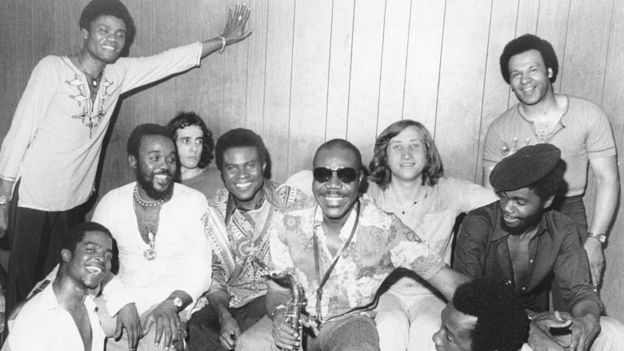 Image copyrightGETTY IMAGES
Image copyrightGETTY IMAGESBorn in the Cameroonian city of Douala in 1933, which at the time was under French colonial rule, Dibango’s musical career spanned across more than six decades.
more...
Ray Mantilla, a percussionist and bandleader who led a prolific jazz career for more than half a century, died on Saturday, at New York-Presbyterian/Columbia University Medical Center. He was 85.
The cause was complications of lymphoma, said his brother, Kermit Mantilla, who was at his bedside when he passed.
Mantilla played on hundreds of recordings, including some that have become important parts of jazz history, like Max Roach’s M’Boom, Herbie Mann’s Flute, Brass, Vibes and Percussion and Charles Mingus’s Cumbia & Jazz Fusion. He was one of the three most recorded conga players in the history of jazz; he held that distinction with Ray Barretto and Cándido Camero.
Like Cándido, one of his heroes, Mantilla championed the use of multiple congas, employing up to four drums at times, each tuned to a specific pitch. Also like Cándido, he championed the performance of solo pieces on congas.
But Mantilla was, as he liked to put it, the complete percussionist — skilled not only on congas but also a range of other instruments. “I loved the way Ray played charanga-style timbales,” Barretto once said. “Remember, you have only one bell to keep time accompanying the flute and violins, and you have to play rock-solid time with swing.”
Mantilla described his own music as “Latin Jazz with authentic Latino rhythms.” He released nine albums as a leader. His first was Mantilla, in 1978, and his most recent was High Voltage, almost 40 years later. He recorded a follow-up, Rebirth, scheduled for release this year on Savant Records.
“It’s a combination of the familiar and the eclectic,” said longtime Mantilla associate Mike Freeman, who plays vibraphone on that album. The title, Rebirth, he explained, “is a reference to Ray surviving cancer two years ago.”
Raymond Mantilla was born in St. Francis Hospital in the South Bronx on June 22, 1934. His father, Carlos Mantilla Ghilardi, was an architect and engineer who was recruited to work on the building of the George Washington Bridge. He then began working for the U.S. Intelligence Services in a branch in Peru, just before the United States’ entry into World War II. Ray’s mother, Ramona Maldonado, hailed from the city of Vega Baja in Puerto Rico, and owned and operated a bodega in the South Bronx.
Ray’s childhood friends included some of the major forces in the Afro-Cuban music scene that became redefined by New York’s City’s Puerto Rican community into what we know as salsa. Among them were timbalero Orlando Marin, percussionist Manny Oquendo, pianist Eddie Palmieri, flutist and percussionist Johnny Pacheco, and percussionist Benny Bonilla.
Bonilla, who played timbales on the seminal Latin Boogaloo hit “I Like It Like That,” met Mantilla at age 15. “He and I would practice our conga beats to 78 vinyl records,” he said. “Ray stressed a steady and good left hand.”
more...This new multiwavelength image of the Crab Nebula combines X-ray light from the Chandra X-ray Observatory (in blue) with visible light from the Hubble Space Telescope (in yellow) and infrared light seen by the Spitzer Space Telescope (in red). This particular combination of light from across the electromagnetic spectrum highlights the nested structure of the pulsar wind nebula.
The X-rays reveal the beating heart of the Crab, the neutron-star remnant from the supernova explosion seen almost a thousand years ago. This neutron star is the super-dense collapsed core of an exploded star and is now a pulsar that rotates at a blistering rate of 30 times per second. A disk of X-ray-emitting material, spewing jets of high-energy particles perpendicular to the disk, surrounds the pulsar. The infrared light in this image shows synchrotron radiation, formed from streams of charged particles spiraling around the pulsar’s strong magnetic fields.
The visible light is emission from oxygen that has been heated by higher-energy (ultraviolet and X-ray) synchrotron radiation. The delicate tendrils seen in visible light form what astronomers call a “cage” around the rich tapestry of synchrotron radiation, which in turn encompasses the energetic fury of the X-ray disk and jets. These multiwavelength interconnected structures illustrate that the pulsar is the main energy source for the emission seen by all three telescopes.
The Crab Nebula resides 6,500 light-years from Earth in the constellation Taurus.
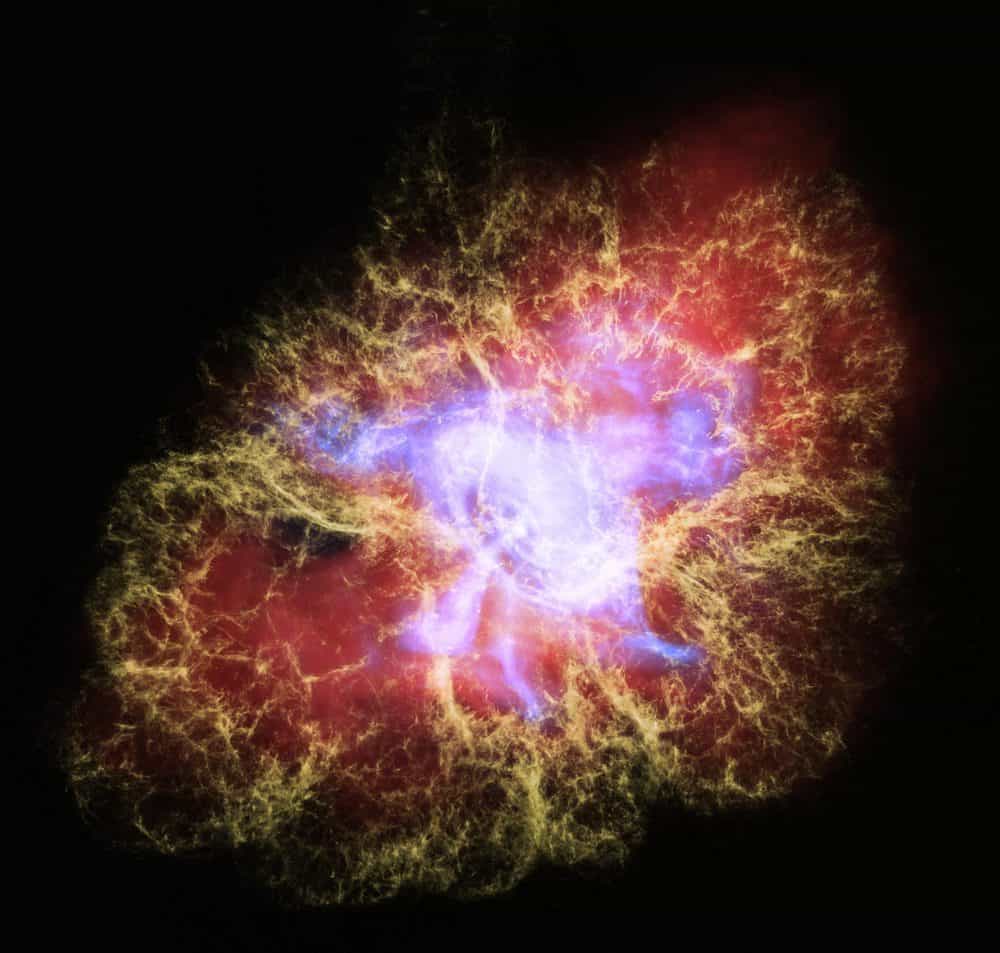
Lee Oskar (born 24 March 1948) is a Danish harmonica player, notable for his contributions to the sound of the rock-funk fusion group War, which was formed by Howard E. Scott and Harold Brown, his solo work, and as a harmonica manufacturer. He continues to play with 3 other original War band members, Harold Brown, Howard Scott and B.B. Dickerson, under the name LowRider Band.
Born in Copenhagen, Denmark in 1948, Oskar was six years old when a family friend gave him his first harmonica. “I came from an area where every kid on the block had a harmonica”, he remembers. He grew up listening to Danish radio, enjoying all types of music and cites Ray Charles as the biggest influence from that period. When he was 17, Oskar decided that the United States was where a harmonica player should make his career. So he moved to New York at the age of 18 with little more than a harmonica in his pocket. With no money, Oskar played harmonica in the streets of New York. Eventually arriving in Los Angeles, via Toronto and San Francisco, Oskar soon met and joined forces with Eric Burdon who had recently disbanded The Animals and was searching for new collaborators. Together, the harmonica-playing Dane (born Lee Oskar Levitin) and the British blues-rock singer made the rounds of the L.A. clubs, eventually hooking up with the soon-to-be members of War. Burdon agreed to the novel idea of pairing up Oskar’s harmonica with Charles Miller‘s saxophone to form a horn section. This team-up set War apart from the start, giving Oskar room to display the full spectrum of his improvisational prowess. Oskar’s harmonica magic was always a vital element in War’s music and performances. Oskar continued with War for 24 years non-stop. At the end of 1992, during the time of dispute over the WAR trademark, Oskar took a few years to continue his solo career and to focus on his Lee Oskar Harmonica manufacturing.
more...Paul Brownlee McCandless Jr. (born March 24, 1947) is an American multi-instrumentalist and founding member of the American jazz group Oregon. He is one of few jazz oboists. He also plays bass clarinet, English horn, and soprano saxophone.
Paul Brownlee McCandless Jr. was born into a musical family. His father taught him clarinet, his mother piano, and he attended the Manhattan School of Music. In 1971 he auditioned with the New York Philharmonic playing English horn and was a finalist.
McCandless has released a series of records of his own compositions with bands he led, including All the Mornings Bring (Elektra/Asylum, 1978), Heresay (Windham Hill, 1988), Navigator (Landslide, 1981), and Premonition (Windham Hill, 1992). With Oregon, he has recorded over twenty albums, as well as several albums with Paul Winter.
In 1996, McCandless won a Grammy Award for Best Pop Instrumental with Béla Fleck and the Flecktones. He also won Grammys in 2007 and 2011 with the Paul Winter Consort for Best New Age Album and in 1993 for Al Jarreau‘s album Heaven and Earth. His performance on Oregon’s album 1000 Kilometers was nominated for a Grammy for Best Jazz Instrumental Solo in 2009. He won the Down Beat Critics’ Poll for Best Established Combo, the Deutscher Schallplatten Preis for his album Ectopia, and the Arbeitskreis Jazz im Bundesverband der Phonographishen Wirtschaft Gold Record Award.
In 1985, McCandless toured Europe with bassist Barre Phillips and German clarinetist Theo Jörgensmann. He has been a guest musician with Béla Fleck and the Flecktones, appearing on the 1999 album Greatest Hits of the 20th Century and the 2002 album Live at the Quick, and has toured with tabla musician Sandip Burman. He was a guest of Leftover Salmon and The String Cheese Incident in the late 1990s. He has appeared on stage in duets with pianist Art Lande, with whom he recorded the album Skylight. Since 2013 he has been playing regularly in Europe with the Samo Salamon Bassless Trio.
more...Carol Kaye (nee Smith, born March 24, 1935) is an American musician. She is one of the most prolific recorded bass guitarists in rock and pop music, playing on an estimated 10,000 recordings in a career spanning over 50 years.
Kaye began playing guitar in her early teens and after some time as a guitar teacher, began to perform regularly on the Los Angeles jazz and big band circuit. She started session work in 1957, and through a connection at Gold Star Studios began working for producers Phil Spector and Brian Wilson. After a bassist failed to turn up to a session in 1963, she switched to that instrument, quickly making a name for herself as one of the most in-demand session players of the 1960s, playing on numerous hits. She moved into playing on film soundtracks in the late 1960s, particularly for Quincy Jonesand Lalo Schifrin, and began to release a series of tutoring books such as How To Play The Electric Bass. Kaye became less active towards the end of the 1970s, but has continued her career and attracted praise from other musicians.
During the peak of her years of session work, she became part of a stable of Los Angeles-based musicians which went by a variety of informal names, but has since become known as “The Wrecking Crew“. Her work with the group led to her prominent role in the eponymous 2008 documentary film.
Kaye was born in Everett, Washington, to professional musicians Clyde and Dot Smith. Her father was a jazz trombonist who played in big bands. In 1942, he sold a piano in order to finance a move to Wilmington, California.
more...Steve Kuhn (born March 24, 1938) is an American jazz pianist, composer, arranger, bandleader, and educator.
Kuhn was born on March 24, 1938, in Brooklyn, New York City. He began studying piano at the age of five and studied under Boston piano teacher Margaret Chaloff, mother of jazz baritone saxophonist Serge Chaloff, who taught him the “Russian style” of piano playing. At an early age he began improvising classical music. As a teenager he appeared in jazz clubs in the Boston area with Coleman Hawkins, Vic Dickenson, Chet Baker, and Serge Chaloff.
After graduating from Harvard, he attended the Lenox School of Music where he was associated with Ornette Coleman, Don Cherry, and Gary McFarland. The school’s faculty included Bill Evans, George Russell, Gunther Schuller, and the members of the Modern Jazz Quartet. This allowed Kuhn to play, study, and create with some of the most forward-thinking innovators of jazz improvisation and composition; it culminated with his joining trumpeter Kenny Dorham‘s group for an extended time and (briefly) John Coltrane‘s quartet at New York’s Jazz Gallery club.
Kuhn also has appeared with Stan Getz, Art Farmer, Oliver Nelson, Gary McFarland, Ron Carter, Scott LaFaro, Harvie Swartz, vocalist Shelia Jordan, Billy Drummond, David Finck, and Miroslav Vitous. From 1967 to 1971 Kuhn moved to Stockholm, Sweden where he worked with his own trio throughout Europe. In 1971 Kuhn moved back to New York City and formed a quartet but continued doing European gigs and appearing at the Newport Jazz Festival.
more...If you stare at an interesting patch of sky long enough, will it look different? In the case of Pleiades and Hyades star clusters — and surrounding regions — the answer is: yes, pretty different. Long duration camera exposures reveal an intricate network of interwoven interstellar dust and gas that was previously invisible not only to the eye but to lower exposure images. In the featured wide and deep mosaic, the dust stands out spectacularly, with the familiar Pleaides star cluster visible as the blue patch near the top of the image. Blue is the color of the Pleiades’ most massive stars, whose distinctive light reflects from nearby fine dust. On the upper left is the Hyades star cluster surrounding the bright, orange, foreground-star Aldebaran. Red glowing emission nebula highlight the bottom of the image, including the curving vertical red ribbon known as the Eridanus Loop. The pervasive dust clouds appear typically in light brown and are dotted with unrelated stars.
The cluster is dominated by hot blue and luminous stars that have formed within the last 100 million years. Reflection nebulae around the brightest stars were once thought to be left over material from the formation of the cluster, but are now considered likely to be an unrelated dust cloud in the interstellar medium through which the stars are currently passing.
Computer simulations have shown that the Pleiades were probably formed from a compact configuration that resembled the Orion Nebula.Astronomers estimate that the cluster will survive for about another 250 million years, after which it will disperse due to gravitational interactions with its galactic neighborhood.
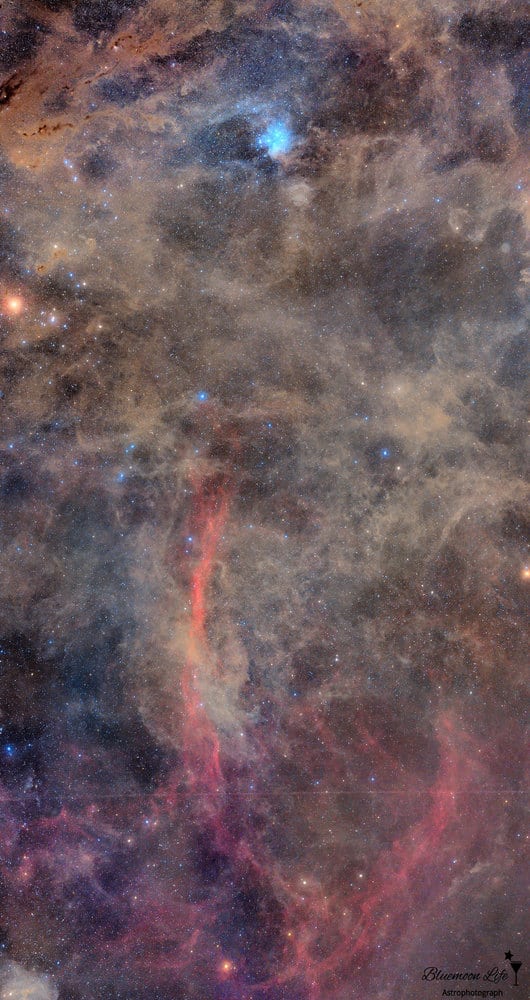
more...
More Posts
- Daily Roots with Prince Fari & Black Skin
- Musicians & Artists Cancellations
- Coronavirus: Deserted Italian street rings out with song as people lean out of windows to sing together during lockdown
- Wisdom in the time of Crisis
- The Cosmos with NGC 3226/7
- Shirley Scott Day
- Quincy Jones Day
- Robert Pete Williams Day
- Les Baxter Day
- World Music with Frigg
- Daily Roots with Gato Negro
- Urinetown Cancelled
- The Cosmos with Gum 15
- Blue Mitchell Day
- Roy Haynes Day
- Lightnin’ Slim Day
- Flamenco Fridays with Paco Cepero y Rancapino Chico
- Daily Roots with Bunny Wailer
- The Cosmos with M31
- James Taylor Day
